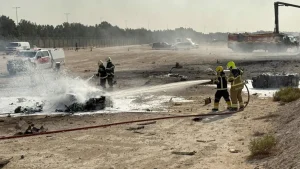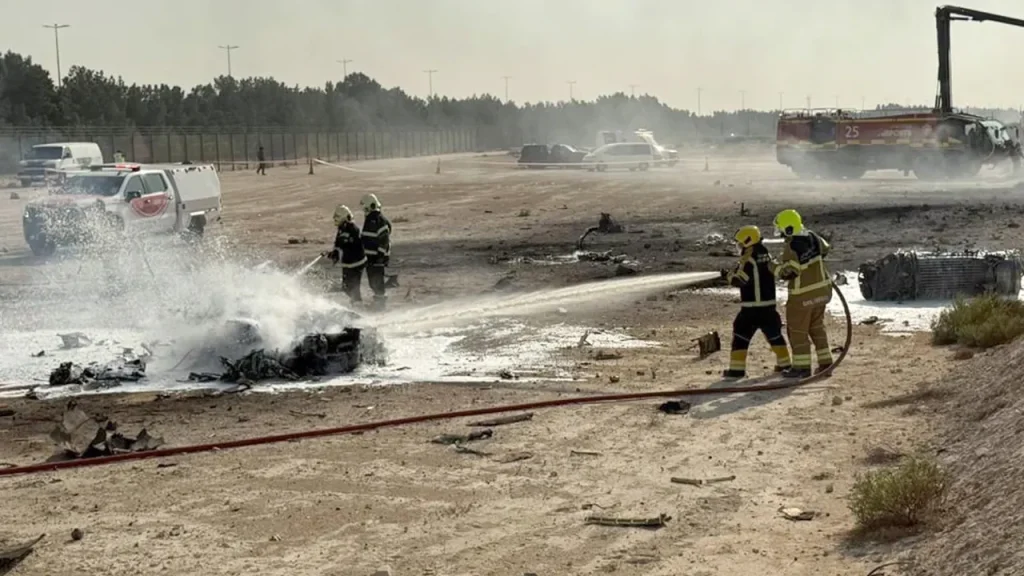Tragedy Strikes Dubai Air Show as Indian Tejas Jet Crashes, Pilot Lost
In a devastating moment that shocked onlookers at the Dubai Air Show on Friday, an Indian Air Force Tejas fighter jet crashed during a flight demonstration, claiming the life of its pilot. The accident unfolded before hundreds of spectators who had gathered to witness the aeronautical displays, with videos capturing the horrific moment the aircraft burst into flames upon impact with the ground. The crash brought a somber tone to what was meant to be a celebration of aviation achievement, with gasps and cries rising from the crowd as the disaster unfolded. In the aftermath, both the Indian Air Force and Dubai authorities quickly acknowledged the tragedy, with the IAF expressing deep regret over the loss and extending condolences to the pilot’s family. The Dubai Media Office confirmed that emergency teams responded rapidly to the scene, though their efforts could not save the airman.
The incident cast a shadow over India’s aerospace ambitions, as the Tejas represents the nation’s indigenous fighter jet program. Developed and built by state-run Hindustan Aeronautics Limited (HAL), the Tejas is a lightweight, single-engine multirole fighter that has been positioned as a critical component in modernizing India’s air defense capabilities. The aircraft’s appearance at the prestigious Dubai Air Show was meant to showcase Indian engineering prowess and potentially attract international interest in the platform. Just months before the crash, in September, India’s Defense Ministry had signed a significant contract with HAL for 97 additional Tejas jets to bolster the air force’s fleet, with deliveries expected to begin in 2027. The timing makes this tragedy particularly poignant, as it occurred during a period when India was actively promoting its aerospace industry on the global stage.
Despite the crash, the air show continued its program after a brief interruption, with the Russian Knights aerobatics team taking to the skies while emergency crews worked at the crash site below. This juxtaposition of ongoing aerial displays against the backdrop of a fatal accident created a surreal atmosphere at the event. Witnesses described seeing an SUV with Indian diplomatic plates arriving at the scene, joining police and emergency personnel who had cordoned off the area. The decision to continue with the air show while recovery efforts were still underway speaks to the complex balance organizers must strike between acknowledging tragedy and maintaining the event’s schedule for thousands of international attendees and industry stakeholders.
The strategic importance of the Tejas extends beyond mere national pride for India. As China continues to expand its military presence across South Asia, including strengthening defense relationships with Pakistan, India has been working diligently to enhance its own defense capabilities. The Tejas program represents India’s push toward greater self-reliance in military equipment, reducing dependency on foreign suppliers and developing domestic aerospace expertise. The fighter jet is expected to play a crucial role in addressing India’s depleted fighter fleet, which has faced challenges maintaining adequate numbers to counter regional threats. This accident comes at a delicate moment in India’s ongoing efforts to position itself as both a regional power and an emerging defense technology provider in the competitive Asian security landscape.
This is not the first incident involving a Tejas aircraft, though previous occurrences had more fortunate outcomes. Last year, another Tejas crashed in Rajasthan, western India, but in that instance, the pilot was able to safely eject from the aircraft before impact. The contrasting results of these two accidents highlight the unpredictable nature of aviation incidents and the thin line between tragedy and near-miss in military aviation. As investigators begin the painstaking process of determining what caused Friday’s crash, questions will inevitably arise about potential systemic issues with the aircraft or its operational procedures. The investigation will need to determine whether this was an isolated incident related to specific circumstances or if there might be broader concerns about the Tejas platform that need to be addressed before the scheduled fleet expansion.
The human dimension of this tragedy cannot be overlooked amid discussions of geopolitics and defense capabilities. Behind every military aircraft is a pilot who accepts extraordinary risks in service to their country. The unnamed pilot lost in Dubai had likely spent years training to master the complex systems of the Tejas, representing the elite of India’s air force. Their death while representing their nation on an international stage adds a particularly poignant dimension to the loss. As the Indian Air Force stated in their announcement, they “stand firmly with the bereaved family in this time of grief” – a reminder that beyond the headlines about crashed jets and military strategies are real people and families whose lives are forever changed by such incidents. While the investigation proceeds and the implications for India’s aerospace program are assessed, the most immediate impact is the profound loss felt by the pilot’s loved ones and colleagues in the tight-knit aviation community.



